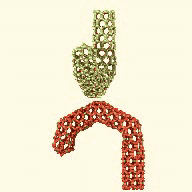Connecting and disconnecting nanotube hooks


Molecular dynamics simulation of the nanohook
closure and opening illustrates the hook resilience
This is the central part of a micro-fastening system that requires no
glue or welding. It is covered by
U.S. Patent 7,181,811 on a
"Micro-Fastening System and Method of Manufacture" by
David Tomanek, Richard Enbody and Young-Kyun Kwon.
Two surfaces, covered by arrays of nanotube-based hooks that are firmly anchored, could
be connected by applying pressure. To some degree, this is reminiscent of the type of
bonding achieved on the millimeter-scale in hook-and-loop fasteners. On the sub-micron
scale, this fastening system opens new possibilities in micro- and nanoelectronics.
Benefits of bonding using mating nanotube hook elements are:
- Unusually strong, permanent bonds
- Self-repairing bonds
- Chemically inert and non-toxic bonds
- Thermally stable connection
- Good thermal and electrical conductance across bonded interface
The underlying Physics is described in
Savas Berber, Young-Kyun Kwon, and David Tománek,
'Bonding and energy dissipation in a nanohook assembly,
Phys. Rev. Lett. 91, 165503 (2003).